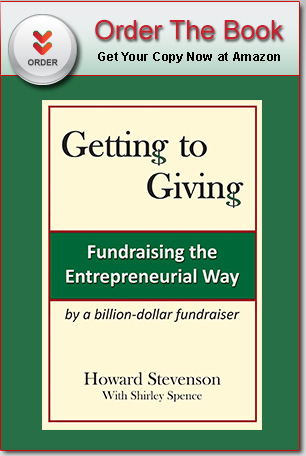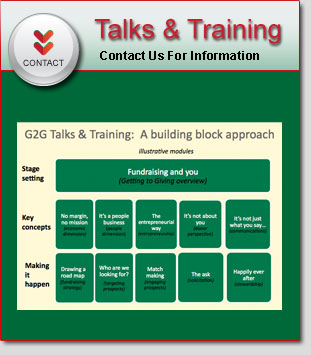That’s a question I have been debating a lot with colleagues – especially board members – recently.
The original use of the term of “capital campaign” was to rally the troops to solve some big capital issues. Fondly referred to as “bricks and mortar” campaigns, they were designed to raise funds for facilities, equipment and permanent endowment. Donors were challenged to make “once in a lifetime” gifts. But that has changed. Some organizations run capital campaigns every five to ten years. Is that rallying the troops or distracting them? Does it force donors to “game” their giving, in anticipation of yet more requests? The purpose of capital campaigns has become blurred too, extending into what some may view as thinly disguised budget relief. What does that do to the organization’s credibility?
Many organizations run capital campaigns almost back-to-back. Campaign directors are in hot demand. “That’s what we do” seems to be the attitude of many development groups. The problem is that the same donors are being hit up time and again for their time, money, and connections. (Let’s not forget that donors are often volunteer fundraisers too.) They may be asked to make annual gifts as well as a capital campaign contribution. Donor fatigue sets in, and the gaming begins. One friend of mine has always hated pledging, but has come to embrace it as a defense against repeated requests. Two problems for the institution: a less than optimal donor experience and relationship; and quite likely a smaller gift than it would have received had my friend been motivated by one really compelling opportunity.
One regional organization considering an $85 million campaign was sobered to realize that it would become one of some sixty-seven in its neighborhood. And competition has increased not just in terms of the sheer number of campaigns but in campaign size as well. To use a rarified example, Stanford set the record for universities with its 2006-2011 capital campaign, which raised $6.23 billion. Guess what Harvard is rumored to be aiming for, in a University-wide effort slated to go public in 2013? (Answer: that much, and more.) For the donor, competition means all that many more calls and letters from often worthy causes. I once counted the mail solicitations I received in just two months: 150 pieces from over 120 organizations.
Sometimes the organization doesn’t have a product to sell. It hasn’t really thought through what the offer is to people. “Give to us, we’re good guys” is the basic approach. Asked for campaign advice by one nonprofit board, I said “don’t do it.” It didn’t have a “big idea” that would warrant the kind of investment it was seeking. Significant donors need to be inspired. They want to have an impact on something they consider important, and feel confident that they can accomplish that through you. That requires knowing your donor and where your cause ranks in his or her giving priorities, and building a solid case as to why he or she should give to you, now.
“Total development” campaigns shouldn’t to be confused with total development programs. The latter refers to an integrated approach to meeting fundraising needs and may include annual funds, endowments and planned giving, and – yes – capital campaigns. A comprehensive capital campaign usually means “count everything”. It often includes a lot that is not “capital”. “When is a capital campaign not a capital campaign?” was one suggested title for this op ed piece. Do we simply have a rhetorical problem?
Yes and no. The problem is a mismatch between current campaign rhetoric and the economic needs of organizations. Think about the types of support and the size of gifts involved in fundraising. Annual funds made up of relatively small gifts work well for most operating needs. Capital funds made up of relatively large gifts make sense for what I’ll call perpetual gifts. What’s often missing in an organization’s funding plan is something in the middle: medium-sized for focused appeals. Sudbury Valley Trustees, a regional land conservation group, is one organization that is savvy about making the distinctions: memberships cover operating expenses; campaigns are run as needed for large land acquisitions; and an endowment was established for ongoing land stewardship expenses.
Sometimes a large, one time chunk of money isn’t really what is needed, from the institutional or the donor perspective. An example: a public radio station was planning a large capital campaign for “financial sustainability.” In fact, the money was earmarked for construction of a new cultural center, investments in new technology initiatives, and an addition to its endowment. Was a large capital campaign the best way to communicate the station’s vision and needs to its constituents? Probably not. Did it really need that big chunk of money? I argued that it would be better served by raising $8 million a year over ten years, a source of marginal income so it could make the necessary investments over time. It’s more attractive to the donor as well as the institution.
If I give a gift with a ten-year spend down, it will generate 13% at 5% interest, or 2.6 times bang for the buck. With a five year spend down, that would yield a 23% distribution, for 5 times bang for the buck. As a donor, I like that. And numbers aside, I would question the point of perpetual funding. I doubt that public media will exist in the same form in ten years, with the rate of technological change going on in the industry. I’d rather give ten years of support, figuring that if the organization is successful, it should have no problem raising more then. That’s the entrepreneurial “snowball” approach to funding growth: invest, document success in achieving outcomes, and make the case for deserving more investment.
How to do decide if you should launch that capital campaign? First, be disciplined about the fundamentals. Is your mission clearly defined, and ambitious but realistic? Next, ask yourself: “How about our economic model? How does what we need the money for impact our mission? Do we need big chunks or more ongoing support? Specifically, how will donor support make a difference? Why should a donor choose to support us?” Never forget that, at the end of the fundraising day, it’s about mission, message and money… from the donor perspective.
The last test is your readiness: Is your leadership visible and supportive of the effort? Is the internal and external climate conducive to fundraising? Are you able to articulate a clear and compelling “case” for support, based on specific plans for the money? If an objective outsider wouldn’t say “yes” to all these questions, then you need to rethink your capital campaign timing and plan.



